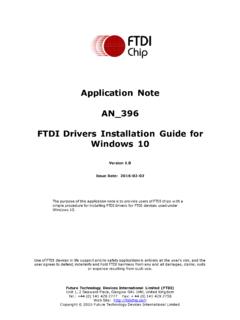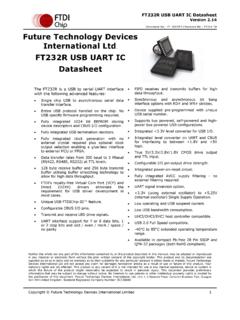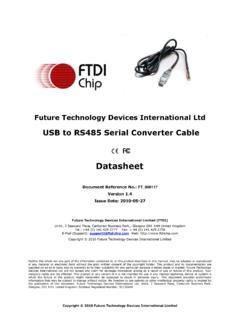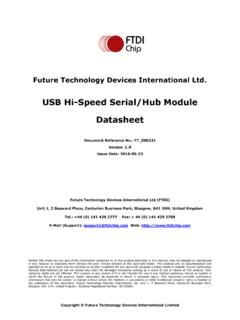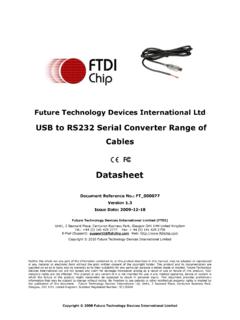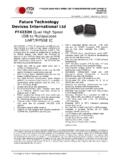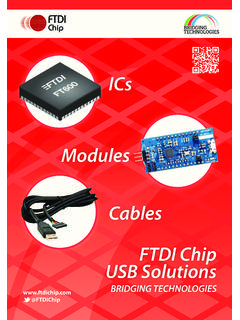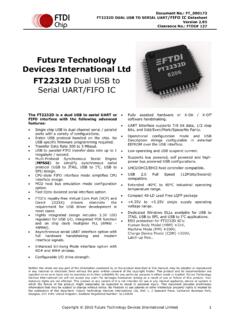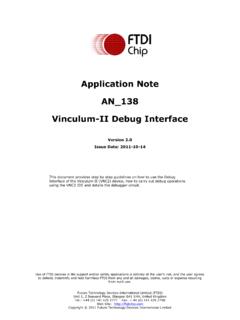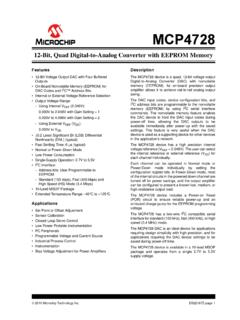Transcription of User Guide For libMPSSE – I2C - FTDI Chip Home …
1 Use of FTDI devices in life support and/or safety applications is entirely at the user s risk, and the user agrees to defend, indemnify and hold harmless FTDI from any and all damages, claims, suits or expense resulting from such use. Future Technology Devices International Limited (FTDI) Unit 1, 2 Seaward Place, Glasgow G41 1HH, United Kingdom Tel.: +44 (0) 141 429 2777 Fax: + 44 (0) 141 429 2758 Web Site: Copyright 2011 Future Technology Devices International Limited Application Note AN_177 user Guide For libMPSSE I2C Document Reference No.: FT_000466 Version Issue Date: 2012-02-13 This application note is a Guide to using the libMPSSE -I2C a library which simplifies the design of firmware for interfacing to the FTDI MPSSE configured as an I2C interface. The library is available for Windows and for Linux Application Note AN_177 user Guide For libMPSSE I2C Version Document Reference No.
2 : FT_000466 Clearance No.: FTDI# 210 1 Copyright 2011 Future Technology Devices International Limited Table of Contents 1 Introduction .. 2 2 System 4 3 Application Programming Interface (API) .. 5 Functions .. 5 I2C_GetNumChannels .. 5 I2C_GetChannelInfo .. 5 I2C_OpenChannel .. 6 I2C_InitChannel .. 7 I2C_CloseChannel .. 7 I2C_DeviceRead .. 8 I2C_DeviceWrite .. 10 GPIO functions .. 12 FT_WriteGPIO .. 12 FT_ReadGPIO .. 13 Library Infrastructure Functions .. 13 Init_libMPSSE .. 13 Cleanup_libMPSSE .. 14 Data types .. 14 ChannelConfig .. 14 I2C_CLOCKRATE .. 15 Typedefs .. 15 4 Example Circuit .. 16 5 Example Program .. 17 6 Contact Information .. 23 Appendix A References .. 24 Document References .. 24 Acronyms and Abbreviations .. 24 Appendix C Revision History.
3 25 Application Note AN_177 user Guide For libMPSSE I2C Version Document Reference No.: FT_000466 Clearance No.: FTDI# 210 2 Copyright 2011 Future Technology Devices International Limited 1 Introduction The Multi Protocol Synchronous Serial Engine (MPSSE) is a generic hardware found in several FTDI chips that allows these chips to communicate with a synchronous serial device such an I2C device, a SPI device or a JTAG device. The MPSSE is currently available on the FT2232D, FT2232H, FT4232H and FT232H chips, which communicate with a PC (or an application processor) over the USB interface. Applications on a PC or on an embedded system communicate with the MPSSE in these chips using the D2XX USB drivers. The MPSSE takes different commands to send out data from the chips in the different formats, namely I2C, SPI and JTAG.
4 libMPSSE is a library that provides a user friendly API to enable users to write applications to communicate with the I2C/SPI/JTAG devices without needing to understand the MPSSE and its commands. However, if the user wishes then he/she may try to understand the working of the MPSSE and use it from their applications directly by calling D2XX functions. Figure 1: The software and hardware stack through which legacy protocol data flows user Application libMPSSE (SPI/I2C/JTAG Library) D2XX API USB Bus driver FTDI USB-to-Legacy bridge chips Legacy protocol slave device Application Note AN_177 user Guide For libMPSSE I2C Version Document Reference No.: FT_000466 Clearance No.: FTDI# 210 3 Copyright 2011 Future Technology Devices International Limited As shown in the above figure, libMPSSE has three different APIs, one each for I2C, SPI and JTAG.
5 This application note only describes the I2C section. The libMPSSE library (Linux or Windows versions), sample code, release notes and all necessary files can be downloaded from the FTDI website at: The sample source code contained in this application note is provided as an example and is neither guaranteed nor supported by FTDI. Application Note AN_177 user Guide For libMPSSE I2C Version Document Reference No.: FT_000466 Clearance No.: FTDI# 210 4 Copyright 2011 Future Technology Devices International Limited 2 System Overview Figure 2: System organisation The above figure shows how the components of the system are typically organised. The PC/Host may be desktop/laptop machine or an embedded system. The FTDI chip and the I2C device would usually be on the same PCB.
6 Though only one I2C device is shown in the diagram above, many devices can actually be connected to the bus if each device has a different I2C address. I2C devices that support configurable addresses will have pins which can be hardwired to give a device an appropriate address; this information may be found in the datasheet of the I2C device chip. Application Note AN_177 user Guide For libMPSSE I2C Version Document Reference No.: FT_000466 Clearance No.: FTDI# 210 5 Copyright 2011 Future Technology Devices International Limited 3 Application Programming Interface (API) The libMPSSE -I2C APIs can be divided into two broad sets. The first set consists of five control APIs and the second set consists of two data transferring APIs. All the APIs return an FT_STATUS.
7 This is the same FT_STATUS that is defined in the D2XX driver. I2C Functions I2C_GetNumChannels FT_STATUS I2C_GetNumChannels (uint32 *numChannels) This function gets the number of I2C channels that are connected to the host system. The number of ports available in each of these chips is different. Parameters: out *numChannels The number of channels connected to the host Returns: Returns status code of type FT_STATUS Note: FTDI s USB-to-legacy bridge chips may have multiple channels in them but not all these channels can be configured to work as I2C masters. This function returns the total number of channels connected to the host system that has a MPSSE attached to it so that they may be configured as I2C masters. For example, if an FT2232D (1 MPSSE port), a FT232H (1 MPSSE port), a FT2232H (2 MPSSE port) and a FT4232H (2 MPSSE ports) are connected to a PC, then a call to I2C_GetNumChannels would return 6 in numChannels.
8 Warning: This function should not be called from two applications or from two threads at the same time. I2C_GetChannelInfo FT_STATUS I2C_GetChannelInfo (uint32 index,FT_DEVICE_LIST_INFO_NODE *chanInfo) This function takes a channel index (valid values are from 0 to the value returned by I2C_GetNumChannels 1) and provides information about the channel in the form of a populated FT_DEVICE_LIST_INFO_NODE structure. Parameters: in index Index of the channel out *chanInfo Pointer to FT_DEVICE_LIST_INFO_NODE structure Returns: Returns status code of type FT_STATUS Application Note AN_177 user Guide For libMPSSE I2C Version Document Reference No.: FT_000466 Clearance No.: FTDI# 210 6 Copyright 2011 Future Technology Devices International Limited Note: This API could be called only after calling I2C_GetNumChannels.
9 See also: Structure definition of FT_DEVICE_LIST_INFO_NODE is in the D2XX Programmer s Guide . Warning: This function should not be called from two applications or from two threads at the same time. I2C_OpenChannel FT_STATUS I2C_OpenChannel (uint32 index, FT_HANDLE *handle) This function opens the indexed channel and provides a handle to it. Valid values for the index of channel can be from 0 to the value obtained using I2C_GetNumChannels 1). Parameters: in index Index of the channel out handle Pointer to the handle of type FT_HANDLE Returns: Returns status code of type FT_STATUS Note: Trying to open an already open channel returns an error code. Application Note AN_177 user Guide For libMPSSE I2C Version Document Reference No.: FT_000466 Clearance No.: FTDI# 210 7 Copyright 2011 Future Technology Devices International Limited I2C_InitChannel FT_STATUS I2C_InitChannel (FT_HANDLE handle, ChannelConfig *config) This function initializes the channel and the communication parameters associated with it.
10 Parameters: in handle Handle of the channel in config Pointer to ChannelConfig structure. Members of ChannelConfig structure contains the values for I2C master clock, latency timer and Options out none Returns: Returns status code of type FT_STATUS See also: Structure definition of ChannelConfig Note: This function internally performs what is required to get the channel operational such as resetting and enabling the MPSSE. I2C_CloseChannel FT_STATUS I2C_CloseChannel (FT_HANDLE handle) Closes a channel and frees all resources that were used by it Parameters: in handle Handle of the channel out none Returns: Returns status code of type FT_STATUS Application Note AN_177 user Guide For libMPSSE I2C Version Document Reference No.: FT_000466 Clearance No.: FTDI# 210 8 Copyright 2011 Future Technology Devices International Limited I2C_DeviceRead FT_STATUS I2C_DeviceRead(FT_HANDLE handle, uint32 deviceAddress, uint32 sizeToTransfer, uint8 *buffer, uint32 *sizeTransferred, uint32 options) This function reads the specified number of bytes from an addressed I2C slave Parameters: in handle Handle of the channel in deviceAddress Address of the I2C slave.
